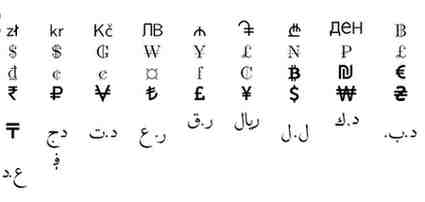Here are some packages that will help you create currency symbols
The textcomp package to create below currency symbols
\usepackage{textcomp}\textbaht
\textdollar
\textdollaroldstyle
\textguarani
\textwon
\textyen
\textlira
\textnaira
\textpeso
\textsterling
\textdong
\textcent
\textcentoldstyle
\textcurrency
\textflorin
\textcolonmonetary
The fontawesome package to create below currency symbols
\usepackage{fontawesome}\faBtc
\faIls
\faEur
\faInr
\faRub
\faViacoin
\faTry
\faGbp
\faJpy
\faUsd
the fontawesome5 package to create below currency symbols
\usepackage{fontawesome5}\faWonSign
\faHryvnia
\faTenge
Now from here, if you would like to travel even further with me then you need to use the tikz package in your LaTeX document
\usepackage{tikz}
Here is the Polish zloty symbol
But tell me, how would I use them?
First, you need to copy and paste these \newcommand lines in your document to create the zloty symbol command
\newcommand{\zloty}{\begin{tikzpicture}
\node [inner sep = 0] at (-0.,0) {${\sf z }$};
\draw [thick] (0.075,-0.) -- (0.165,0.1);
\draw [xshift=0.2mm][thick] (0.1,-0.075) -- (0.1,0.15);
\end{tikzpicture}}Thats it ! Now, your new command is ready to be used anywhere in the document
\zloty 
Here are Swedish, Danish, Norwegian, Icelandic Krona symbol
\newcommand{\krona}{\begin{tikzpicture}
\node [inner sep = 0] at (-0.,0) {${\sf kr }$};
\end{tikzpicture}}
\krona![]()
Here is the Czech koruna symbol
\newcommand{\koruna }{\begin{tikzpicture}
\node [inner sep = 0] at (0.140,0.1) {\tiny \sf v};
\node [inner sep = 0] at (-0.,0) {${\sf Kc }$};
\end{tikzpicture}}
\koruna ![]()
Now here, if you like to create Bulgarian lev then you should have these two packages in your LaTeX document.
\usepackage{tikz}
\usepackage{fdsymbol}Here is the Bulgarian lev
\newcommand{\Bulgarianlev }{\begin{tikzpicture}
\draw [thick] (-0.150,-0.120) -- (-0.150,0.125);
\draw [thick] (-0.285,0.115) -- (-0.150,0.115);
\node [inner sep = 0] at (-0.025,0) {${\sf B }$};
\node [inner sep = 0] at (-0.285,0) {$\smallint$};
\end{tikzpicture}}
\Bulgarianlev 
Here is the Azerbaijani Manat
\newcommand{\Manat}{\begin{tikzpicture}
\draw [thick,inner sep=0] (0,-0.2) arc [radius=0.1,inner sep=0,start angle=190,end angle= -10];
\draw [thick] (0.1,-0.2) -- (0.1,-0.015);
\end{tikzpicture}}\Manat
here is the Armenian dram
\newcommand{\Armeniandram}{\begin{tikzpicture}
\draw [thick,inner sep=0] (0,-0.2) arc [radius=0.1,inner sep=0,start angle=175,end angle= -10];
\draw [thick] (0.199,-0.4) -- (0.199,-0.20);
\draw [thick] (0.1,-0.255) -- (0.293,-0.255);
\draw [thick] (0.1,-0.325) -- (0.293,-0.325);
\end{tikzpicture}}\Armeniandram
Here is the Georgian lari
\newcommand{\Lari}{\begin{tikzpicture}
\draw [thick,inner sep=0] (0.035,-0.8) arc [radius=0.1,inner sep=0,start angle=240,end angle= 0];
\draw [thick] (0.125,-0.715) -- (0.125,-0.555);
\draw [thick] (0.065,-0.715) -- (0.065,-0.555);
\draw [thick] (-0.045,-0.8) -- (0.175,-0.8);
\end{tikzpicture}}\Lari
Here is the Macedonian denar
\newcommand{\Macedoniandenar}{\begin{tikzpicture}
\draw [thick,inner sep=0] (-0.505,-0.085) arc [radius=0.1,start angle=295,end angle= 350];
\draw [thick] (-0.465,0.115) -- (-0.315,0.115);
\draw [thick] (-0.450,-0.015) -- (-0.450,0.115);
\draw [thick] (-0.330,-0.070) -- (-0.330,0.115);
\draw [thick] (-0.485,-0.085) -- (-0.310,-0.085);
\draw [thick] (-0.485,-0.075) -- (-0.485,-0.155);
\draw [thick] (-0.310,-0.075) -- (-0.310,-0.155);
\node [inner sep = 0] at (-0.265,0) {{\Large{ \sf e}}};
\node [inner sep = 0] at (-0.015,0) {{{ \sf H}}};
\end{tikzpicture}}
\Macedoniandenar
now from here, if you have decided to travel even further then you need these four packages
\usepackage{arabtex}
\usepackage{utf8}
\setcode{utf8}
\usepackage{tikz}Here is the Algerian dinar
\RL{ d\nospace G } 
Here is the Tunisian dinar
\RL{ d\nospace.\nospace t } 
Here is the Omani rial
\RL{ r.\hspace{1mm} P } 
Here is the Qatari riyal
\newcommand{\Qataririyal}{\begin{tikzpicture}
\node [inner sep = 0] at (-0.065,0) { \RL{ q } } ;
\node [inner sep = 0] at (0.130,0) { \RL{.} } ;
\node [inner sep = 0] at (0.250,0.055) { \RL{ r } };
\end{tikzpicture}}\Qataririyal
Here is the Iranian, Yemeni rial
\newcommand{\rial}{\begin{tikzpicture}
\node [inner sep = 0] at (-0.065,0) { \RL{ l } } ;
\node [inner sep = 0] at (0.130,0) { \RL{yaa} } ;
\node [inner sep = 0] at (0.250,0.065) { \RL{ r } };
\end{tikzpicture}}\rial
Here is the Lebanese pound
\RL{l.\hspace{0.80mm} l } 
Here is the Kuwaiti dinar
\newcommand{\Kuwaitidinar}{\begin{tikzpicture}
\node [inner sep = 0] at (-0.065,0) { \RL{ k } } ;
\node [inner sep = 0] at (0.130,0) { \RL{.} } ;
\node [inner sep = 0] at (0.240,0.025) { \RL{ d } };
\end{tikzpicture}}\Kuwaitidinar
Here is the Bahraini dinar
\RL{ d\nospace.\nospace b. }
Here is the Iraqi dinar
\RL{ P\nospace.\nospace d } 
here is the afghani
\newcommand{\afghani}{\begin{tikzpicture}
\node [inner sep = 0] at (0.1,0.055) {\RL{ fa-} };
\draw [thick] (0.1,-0.075) -- (0.1,-0.015);
\end{tikzpicture}}\afghani


Leave a Reply